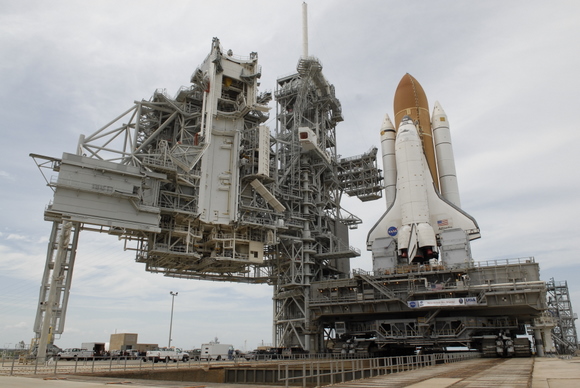[/caption]
Thursday afternoon space shuttle Atlantis rolled out to Launch Pad 39A at the Kennedy Space Center, making it’s slow 5.1 km (3.2 mile) journey along the crawlerway from the Vehicle Assembly Building. NASA mission managers cleared the shuttle’s move after a weather briefing on the status of Tropical Storm Hanna which determined the storm would remain far enough off shore to not cause any problems for the shuttle exposed out on the pad. Atlantis’ seven-member crew are set for an equipment test Friday at Kennedy in preparation for their mission to service NASA’s Hubble Space Telescope. The telescope has already rewritten the books on astronomy and will remain operational for at least another five years following the upgrades. Atlantis is targeted to launch Oct. 8 on mission STS-125. However, another hurricane, Ike, lurks out in the waters of the Atlantic, and could cause problems. But NASA is betting it won’t turn north and head for Florida.
Hubble Servicing Mission No. 4 is the only flight left on NASA’s shuttle manifest that is not headed to the International Space Station. Because Hubble is in a different orbit, Atlantis’ crew cannot seek “safe haven” on the ISS in case of any problems that might prevent a safe re-entry.
Therefore, a second shuttle, Endeavour, will head out to Launch Pad 39 B on Sept. 19, and be ready and on alert for a rescue mission. But if no rescue flight is needed, Endeavour will be moved to pad 39A and prepared for launch on the next ISS assembly mission around Nov. 10.
News Source: NASA


Why move Endeavour again? What’s wrong with 39B?
Its great their repairing Hubble again,it does great science,Met john Grunsfeldt a couple years ago,he’s a great guy and a heck of a astronaut,really down to earth and a great speaker.
Finally – a worthwhile shuttle mission to get excited about! Great to see Hubble getting the TLC it deserves.
I wish they would have completed a Hubble II; all new, state of the art design, and shot it up on an expendable rocket into a higher orbit. Barring a natural disaster, it would last at least 10 years.